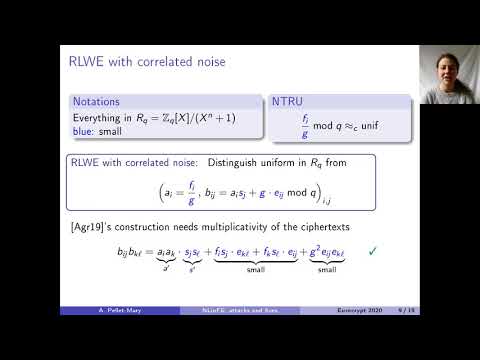Welcome to the resource topic for 2020/415
Title:
Indistinguishability Obfuscation Without Maps: Attacks and Fixes for Noisy Linear FE
Authors: Shweta Agrawal, Alice Pellet-Mary
Abstract:Candidates of Indistinguishability Obfuscation (iO) can be categorized as direct'' or bootstrapping based’'. Direct constructions rely on high degree multilinear maps [GGH13,GGHRSW13] and provide heuristic guarantees, while bootstrapping based constructions [LV16,Lin17,LT17,AJLMS19,Agr19,JLMS19] rely, in the best case, on bilinear maps as well as new variants of the Learning With Errors (LWE) assumption and pseudorandom generators. Recent times have seen exciting progress in the construction of indistinguishability obfuscation (iO) from bilinear maps (along with other assumptions) [LT17,AJLMS19,JLMS19,Agr19]. As a notable exception, a recent work by Agrawal [Agr19] provided a construction for iO without using any maps. This work identified a new primitive, called Noisy Linear Functional Encryption (NLinFE) that provably suffices for iO and gave a direct construction of NLinFE from new assumptions on lattices. While a preliminary cryptanalysis for the new assumptions was provided in the original work, the author admitted the necessity of performing significantly more cryptanalysis before faith could be placed in the security of the scheme. Moreover, the author did not suggest concrete parameters for the construction. In this work, we fill this gap by undertaking the task of thorough cryptanalytic study of NLinFE. We design two attacks that let the adversary completely break the security of the scheme. To achieve this, we develop new cryptanalytic techniques which (we hope) will inform future designs of the primitive of NLinFE. From the knowledge gained by our cryptanalytic study, we suggest modifications to the scheme. We provide a new scheme which overcomes the vulnerabilities identified before. We also provide a thorough analysis of all the security aspects of this scheme and argue why plausible attacks do not work. We additionally provide concrete parameters with which the scheme may be instantiated. We believe the security of NLinFE stands on significantly firmer footing as a result of this work.
ePrint: https://eprint.iacr.org/2020/415
Talk: https://www.youtube.com/watch?v=1d1IVvm12M8
Slides: https://iacr.org/submit/files/slides/2020/eurocrypt/ec2020/301/slides.pdf
See all topics related to this paper.
Feel free to post resources that are related to this paper below.
Example resources include: implementations, explanation materials, talks, slides, links to previous discussions on other websites.
For more information, see the rules for Resource Topics .
